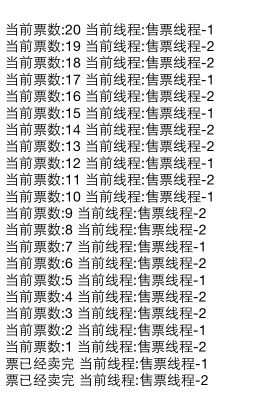NSThread具体使用:直接继承NSObject
FOUNDATION_EXPORT NSString * const NSWillBecomeMultiThreadedNotification;
+ (void)detachNewThreadSelector:(SEL)selector toTarget:(id)target withObject:(id)argument;
※是否是多线程
+ (BOOL)isMultiThreaded;
※定时休眠
+ (void)sleepUntilDate:(NSDate *)date;
※休眠时间
+ (void)sleepForTimeInterval:(NSTimeInterval)ti;
※退出线程
+ (void)exit;
※线程优先级
+ (double)threadPriority;
※设置线程优先级
+ (BOOL)setThreadPriority:(double)p;
※显示当前栈内容(返回的是这个线程在栈中所占的地址所组成的数组)
+ (NSArray *)callStackReturnAddresses;
※返回栈空间的符号
+ (NSArray *)callStackSymbols;
※是否是主线程
+ (BOOL)isMainThread;
※创建线程的实例方法,并添加执行事件
- (instancetype)initWithTarget:(id)target selector:(SEL)selector object:(id)argument;
※取消线程
- (void)cancel;
※启动线程
- (void)start;
※线程主体要执行的方法 :thread body method
- (void)main;
※调用主线程,传入一个与主线程RunLoop循环执行有关的数组
- (void)performSelectorOnMainThread:(SEL)aSelector withObject:(id)arg waitUntilDone:(BOOL)wait modes: (NSArray *)array;
※调用主线程更新UI
- (void)performSelectorOnMainThread:(SEL)aSelector withObject:(id)arg waitUntilDone:(BOOL)wait;
※调用指定的线程,传入一个与线程RunLoop循环执行有关的数组
- (void)performSelector:(SEL)aSelector onThread:(NSThread *)thr withObject:(id)arg waitUntilDone:(BOOL)wait modes:(NSArray *)array;
※调用指定的线程更新数据
- (void)performSelector:(SEL)aSelector onThread:(NSThread *)thr withObject:(id)arg waitUntilDone: (BOOL)wait;
※在后台调用线程- (void)performSelectorInBackground:(SEL)aSelector withObject:(id)arg;
具体举例如下:多线程卖票(要求:把当前票数和当前线程的名字显示在文本视图上)
1.在控件工具中拖拽一个文本视图控件并与类相关联
@property (weak, nonatomic) IBOutlet UITextView *textView; //拖拽一个文本视图控件并与类关联
2.准备数据,并将文本视图中默认的内容置空
//准备资源
_tickets = 20;
//将默认文本视图中的内容置空
self.textView.text = @"";
//取消自动布局,用来控制文本视图的滚动
self.textView.layoutManager.allowsNonContiguousLayout = NO;
3.创建两个线程买票
//创建两个线程并启动线程
//售票线程-1
NSThread *thread1 = [[NSThread alloc]initWithTarget:self selector:@selector(saleTicket) object:nil];
//设置线程的名字,以区别不同的线程
[thread1 setName:@"售票线程-1"];
//启动线程
[thread1 start];
//售票线程-2
NSThread *thread2 = [[NSThread alloc]initWithTarget:self selector:@selector(saleTicket) object:nil];
//设置线程的名字,以区别不同的线程
[thread2 setName:@"售票线程-2"];
//启动线程
[thread2 start];
4.为主线程创建一个方法,专门用来更新并显示UI的
#pragma mark -更新UI
-(void)appendTextView:(NSString *)text
{
//1.获取textView中已有的内容
NSMutableString *stringM = [[NSMutableString alloc]initWithString:self.textView.text];
//2.追加新的内容
[stringM appendString:[NSString stringWithFormat:@"
%@",text]];
[self.textView setText:stringM];
//3.调节焦点,滚动视图
NSRange range = NSMakeRange(stringM.length, 1);
[self.textView scrollRangeToVisible:range];
}
5.为买票线程创建一个方法,负责买票
#pragma mark -卖票的过程
在方法-(void)saleTicket
{
while (YES) {
执行代码如下:
}
}
//当票数大于0时,即if(_tickets>0)时,
操作数据并更新UI为:
//并发执行时,采用同步代码块加锁,防止数据在一个线程的操作过程中被另一个线程抢占篡改,锁必须是唯一的
@synchronized(self)
{
//拼接字符串(当前数据信息)
NSString *str = [NSString stringWithFormat:@"当前票数:%d 当前线程:%@",_tickets,[[NSThread currentThread]name ]];
//调用主线程,更新UI
[self performSelectorOnMainThread:@selector(appendTextView:) withObject:str waitUntilDone:YES];
_tickets--;
}
进行休眠为:
//休眠一段时间,模拟耗时操作
if([[[NSThread currentThread]name] isEqualToString:@"售票线程-1"])
{
[NSThread sleepForTimeInterval:0.3f];
}
else
{
[NSThread sleepForTimeInterval:0.2f];
}
//当票数小于或等于0时,更新UI,并结束线程
//拼接字符串(当前数据信息)
NSString *str = [NSString stringWithFormat:@"票已经卖完 当前线程:%@",[[NSThread currentThread]name]];
//调用主线程,更新UI
[self performSelectorOnMainThread:@selector(appendTextView:) withObject:str waitUntilDone:YES];
break; //结束while死循环,结束线程
演示结果如下:

当然,上面采用的是同步代码块隐式处理线程同步的问题,还可以采用显式加锁的方式来防止数据同步。
首先,声明一个NSLock的锁对象
@property (strong,nonatomic)NSLock *lock;
然后将上面的@synchronized(self)代码做修改,如下:
//在访问竞争资源前加锁
[self.lock lock];
//拼接字符串(当前数据信息)
NSString *str = [NSString stringWithFormat:@"当前票数:%d 当前线程:%@",_tickets,[[NSThread currentThread]name]];
//调用主线程,更新UI
[self performSelectorOnMainThread:@selector(appendTextView:) withObject:str waitUntilDone:YES];
_tickets--;
//访问完竞争资源马上解锁
[self.lock unlock];
演示结果相同:
